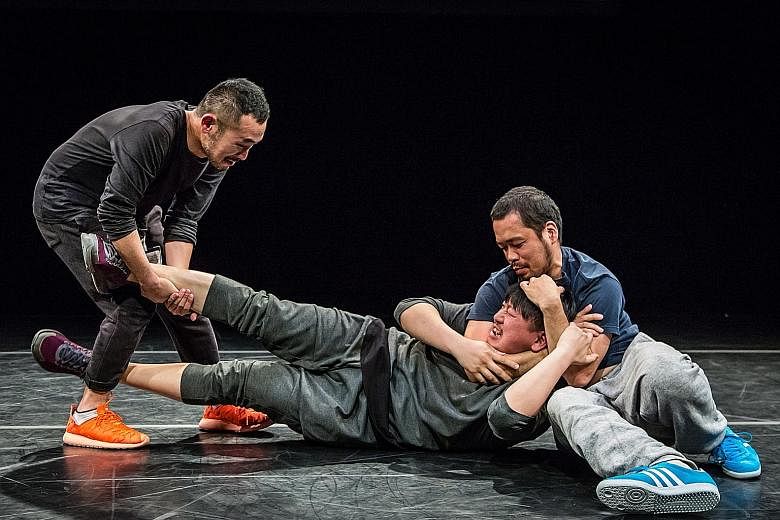Artist Choy Ka Fai, 36, is ready to be grappled, pummelled and bruised on stage at the Singapore premiere of his da:ns festival commission.
The production, named SoftMachine, is a documentary-cum- live performance. It features five dancer-choreographers from four Asian countries. Two of them, including Japan's Yuya Tsukahara, will perform opposite Choy, a multi-disciplinary artist who has worked in theatre, dance and the visual arts.
Tsukahara is the leader of Contact Gonzo, a group in Japan that practises a unique form of improvisational performance where dancers maintain physical contact with one another through martial arts-like moves.
In Choy's piece with Tsukahara, the artist will pose questions to the dancer - between body bumps and blows - about Tsukahara's practice of contemporary dance and choreography. This is to flesh out the flow of thoughts and ideas that inform new experiences in dance in Asia.
Choy's interest in the subject was sparked in 2011 after a dance season at the prestigious London performance venue, Sadler's Wells Theatre, left him cold.
-
BOOK IT / SOFTMACHINE
-
WHERE: Esplanade Theatre Studio
WHEN: Part A: Surjit Nongmeikapam (India) and Rianto (Indonesia), Oct 17, 3pm and Oct 18, 8pm; Part B: Xiao Ke x Zi Han (China) and Yuya Tsukahara (Japan), Oct 17, 8pm and Oct 18, 3pm
ADMISSION: $30 for each part, from Sistic
Billed as Out Of Asia, the season featured well-known names such as British dancer Akram Khan, who is of Bangladeshi descent, French- Vietnamese choreographer Ea Sola and Taiwanese choreographer Lin Hwai-min.
Choy tells Life in a recent phone interview from Berlin, where he is based: "The programme made me realise I was not interested in what was coming out of Asia, but what is inside Asia."
More specifically, he was curious about the thought processes in Asian contemporary dance choreography. The question had been at the back of his mind as he wrapped up his project, Prospectus For A Future Body (2009-2011), which "hijacks the connection between the brain and the dancing body" by turning choreography into electrical simulation which may be reproduced in any body.
Choy, however, found few answers to his questions.
"I couldn't find much material, it was fragmented and in different languages. So I thought maybe I should try to start something, not just for myself, but also for other artists working in Asia."
With that, SoftMachine was born.
From 2012 to 2013, he travelled to 13 Asian cities where he picked the brains of 88 dance-makers. He asked them questions about their personal journeys in dance as well as the development of the dance scene where they are based, linking the past to the present and future of contemporary dance in Asia.
To keep the project manageable, he limited his research to five Asian countries with distinct histories and developments in contemporary dance - Singapore, China, Japan, India and Indonesia.
The fruits of his investigation have been borne in two forms. The first is an online archive, in the pipeline, of video interviews and documentaries of the dance-makers he spoke to. The second is a documentary-cum-live performance, which was presented recently in Europe and will be staged at da:ns festival.
Choy's original idea for the performance was to have four dancers from the countries he researched create a piece of intercultural dance. But he quickly changed his mind.
"If I made the performance into a multicultural thing," he says, "which is quite trendy nowadays, then it would become like any other show. So my attention shifted back to performing the process of my research and collaboration."
On stage, this translates into an intimate solo by Indonesian dancer-choreographer Rianto, who performs his autobiography, touching on issues of gender in dance, and a playful exchange between Choy and Indian dancer Surjit Nongmeikapam that highlights the exoticism of Asia. These two performances make up Part A of the two-part show at the Esplanade.
Part B comprises a performance by Chinese dancers Xiao Ke and Zi Han, which explores the cultural symbolism of gestures, and Choy's piece with Tsukahara and another member of Contact Gonzo.
Tickets to each part of the show are sold separately.
On his piece with Tsukahara, which previously left him with a blue-black chest and unable to smile and laugh for a week because of a swollen cheek, Choy says: "Contact Gonzo members suffer various small injuries all the time, such as broken arms and fractured ribcages, so they think I should just get used to it."

